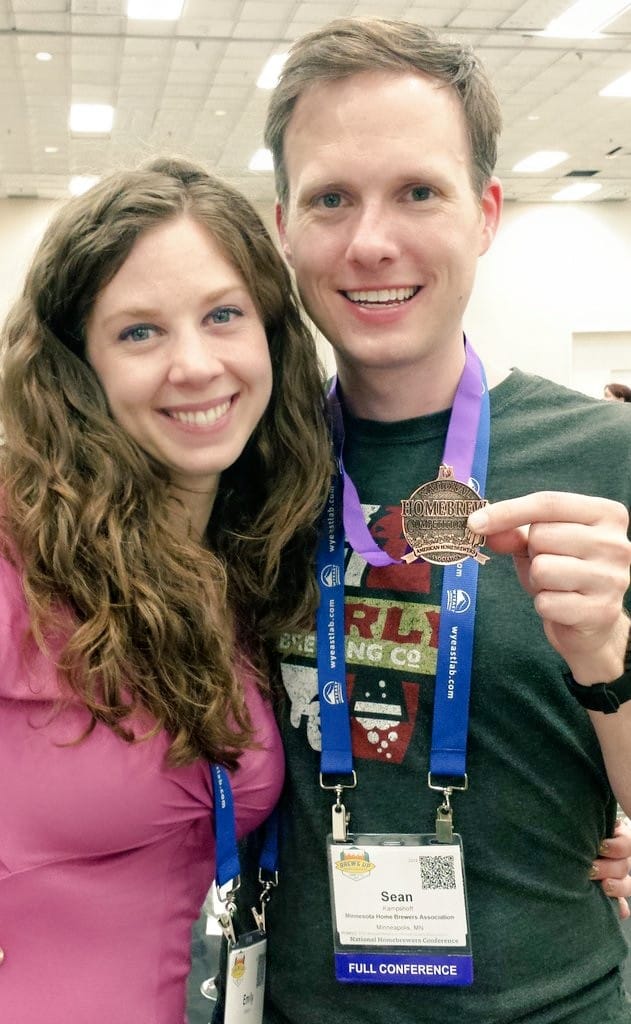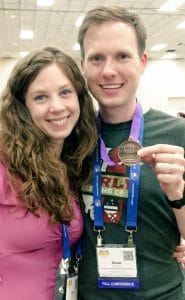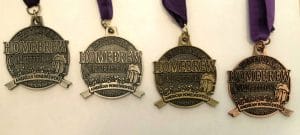The freedom to experiment and explore are the qualities that attract many into the homebrewing hobby. In fact, homebrewers oftentimes lead the way in style and flavor-combination development. Which in turn leads to award-winning brews.
In this Homebrew Spotlight, award-winning homebrewer Sean Kampshoff shares one of his favorite recipes. Sean took up homebrewing in 2005 and is member of both the Minnesota Homebrewer’s Association and Primary Fermenters homebrew clubs. He is a Certified BJCP judge and is an impressive 4-time National Homebrew Competition medal winner.
What do you enjoy most about homebrewing?
For me I like how homebrewing combines artistry/creativity with science/engineering. I get to exercise both of those areas pretty much equally with the hobby. On the creative side I get to formulate new recipes and try out different ingredients and on the engineering side with buying/building new pieces of equipment for brewing.
Why do you enter competitions?
Originally I started entering competitions because I wasn’t sure my beers were any good. At the time I didn’t have a palate that was developed enough to understand if some of the styles I attempted to emulate were up to par. After going through the BJCP prep class taught by Gera Exire LaTour, taking the tasting and written BJCP exams along with a decent amount of judging I feel like I can understand my beers enough where that isn’t needed as much. However, I still like the impartiality of them and the honest feedback that I may not get from myself or friends. So, I still enter for that reason but I also enter to win medals of course.
What advice can you give about entering competitions to increase the chances of winning?
Brewing more and reading more are major things that I think can lead to success. By brewing more I mean trying a lot of different styles instead of just sticking to your favorites. I’ve brewed every 2008 BJCP style and while there were a few I didn’t like (I’m looking at you Roggenbier!) I think all of them taught me something whether it be malt components, lager technique or yeast strain differences that made me a more well-rounded brewer. For reading more, buy more homebrewing books as well as homebrewing magazines to further your knowledge and get ideas. Also, there’s a lot of information in popular homebrewing podcasts that I think is extremely valuable. If you don’t also increase your knowledge from other people/sources while brewing you may get yourself stuck in a rut of producing mediocre beer that never improves. Lastly, going through the BJCP prep class and exams can have a lasting impact. If you have a palate that can recognize a problem with your beer up front you can figure out how to correct it in the future.
Tell us about the recipe you are sharing.
It was brewed for the 2014 National Homebrew Competition and won a Gold medal in the Specialty category. A few years ago at a beer festival my girlfriend Emily fell in love with Surly Brewing’s fourth anniversary beer “Four” which is an iced double milk stout with espresso. Since that beer is tough to come by and Surly hasn’t rebrewed the beer (yet!) I decided to try to make something similar to it. The first couple of batches including the one that medaled at NHC 2014 were eis’d to reach the 10% ABV. But with the most recent batches I’ve instead bumped up the gravity and tweaked the specialty malts a little to reach that ABV since the eis-ing process is a lot of work that I don’t want to do.
Of course, award-winning brews don’t happen without fantastic ingredients. BSG Handcraft is proud to be able to be the distributor of quality ingredients like many of those in Sean’s recipe. Thanks to Sean for sharing his story and recipe and to all homebrewers for doing what you do. Brew on!
Emily
Batch Size: 12.50 gal
OG: 1.110 SG
FG: 1.035 SG
Bitterness: 56 IBU (Rager)
Boil Time: 75 min
ABV: 10 %
Efficiency: 75.00 %
Color: 51 SRM
Crisp Maris Otter 3.0 SRM 40.00 lbs 76.02 %
Simpsons Crystal Medium 80.0 SRM 3.00 lbs 5.70 %
Crisp Pale Chocolate Malt 200.0 SRM 2.50 lbs 4.75 %
Milk Sugar (Lactose) 0.0 SRM 2.50 lbs 4.75 %
Weyermann Carafa Type 1 300.0 SRM 2 lbs 5 oz. 4.39 %
Crisp Roasted Barley 500.0 SRM 2 lbs 5 oz. 4.39 %
Magnum 12.00% AA 3.25 oz 60 min 56 IBU
Whirlfloc
Dry English Ale Yeast (WLP007) 6 packages. 2×2000 ml starters with 3 packages per flask on stir plates for 24 hours. Cold crash flasks overnight and decant spent starter liquid.
Mash in at 154 F for 60 minutes. Mash out at 168 F. Run off to boil kettle. Bring to a boil, then boil 15 minutes. Add hops and boil another 45 minutes. Add Whirlfloc and Lactose and boil for an additional 15 minutes.
Ferment at 66 F for 2 days and then allow free rise to approximately 72 F until fermentation is complete. Attenuation will be lower than expected and gravity readings higher than expected due to the lactose’ lack of fermentability.
At kegging/bottling time, prepare the cold press coffee addition. For my coffee beers I use a Toddy Cold Brew System but a muslin bag and large enough pot can be used instead. Take 12 ounces of coarsely ground coffee and add it to 56 ounces of filtered water. Let sit at room temperature for 12-24 hours. Remove muslin bag or in the case of the Toddy the rubber stopper.
Taste test varying ratios of beer to cold press with sample glasses and a syringe to determine desired amount to be added to keg, bottling bucket or individual bottles. I’ve used anywhere from 0.75 ml cold press to ounce beer to 1.25 ml to ounce in the past depending on the coffee variety and results of the batch and cold press. Look for a balance between the roasted and milk stout qualities of the beer with the coffee ensuring that none of them are overpowered by the other. Overdoing coffee additions can make a beer overly harsh and have it lose all of the malt complexity.
Once a ratio is determined add the cold press to the keg, bottling bucket or individual bottles. I keg this beer without the coffee addition and save that for bottling/serving time since I like to have the coffee flavor as fresh as I possibly can.


